The Madagascar Harrier-hawk (Polyboroides radiatus) stands as a testament to the distinctive avian biodiversity of Madagascar, the fourth largest island in the world.
Characterized by its striking appearance and unique behaviors, this bird of prey captures the attention of ornithologists and bird enthusiasts alike.
With a captivating coloration featuring dark brown upperparts, and a chestnut underbelly, the Madagascar Harrier-hawk showcases its adaptability in diverse habitats, including open grasslands and marshes.
Renowned for its low-flying hunting style and ground-nesting behavior, this species establishes monogamous bonds and actively engages in the rearing of its offspring.
As an endemic resident of Madagascar, the harrier-hawk plays a vital role in the island’s ecosystems, making its conservation imperative in the face of environmental challenges.
Understanding the intricacies of this raptor unveils not only its role in the island’s ecology but also the broader marvels of Madagascar’s avian diversity.
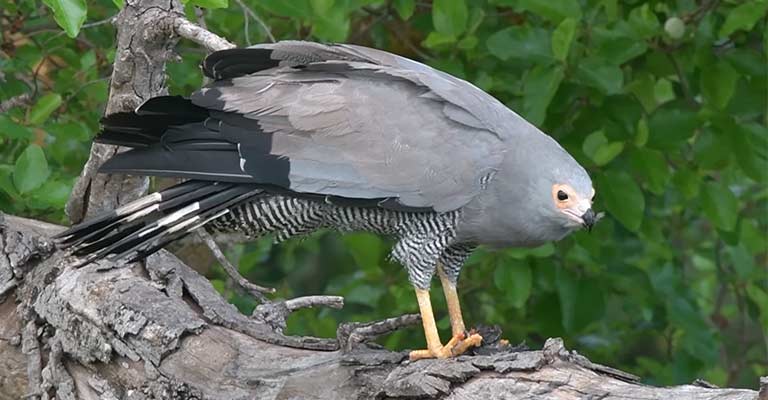
Identifying Characteristics of Madagascar Harrier-hawk
The Madagascar Harrier-hawk (Polyboroides radiatus) is a distinctive bird of prey that can be found in the unique ecosystems of Madagascar.
Identifying this species requires a keen eye for specific characteristics that set it apart from other raptors. Here are some key points to help you identify the Madagascar Harrier-hawk:
Distinctive Coloration
The Madagascar Harrier-hawk exhibits a striking coloration that aids in its identification.
The upper parts of the bird are predominantly dark brown, while the underparts, including the chest and belly, are characterized by a contrasting rufous or chestnut color.
This color pattern is essential for distinguishing it from other raptors in the region.
Facial Features
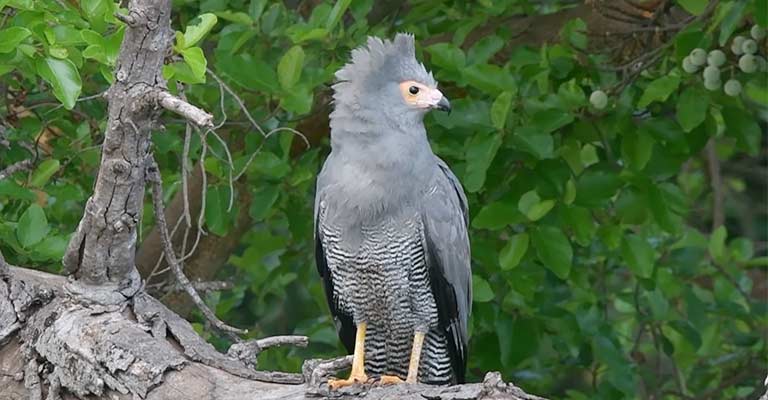
One of the prominent features of this bird is its facial markings. The Madagascar Harrier-hawk typically has a black facial mask, extending from the eyes to the nape of the neck.
This distinctive mask gives the bird a unique and easily recognizable appearance.
Long, Slender Wings
In flight, the Madagascar Harrier-hawk can be identified by its long and slender wings.
These wings are adapted for soaring and maneuvering through the varied landscapes of Madagascar. Observing the bird in flight can provide valuable clues for identification.
Tail Pattern
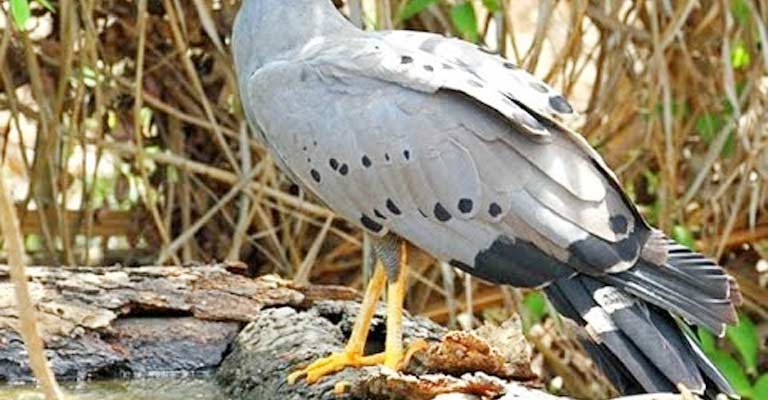
The tail of the Madagascar Harrier-hawk is notable for its distinct banding. Dark bands alternate with lighter ones, creating a pattern that is characteristic of this species.
This feature is particularly evident when the bird is in flight, making it a useful identification marker.
Size and Shape
While in flight, the Madagascar Harrier-hawk presents a medium-sized and compact silhouette.
Its overall shape, including the combination of body size, wing length, and tail shape, helps differentiate it from other birds of prey inhabiting the same region.
Habitat Preference
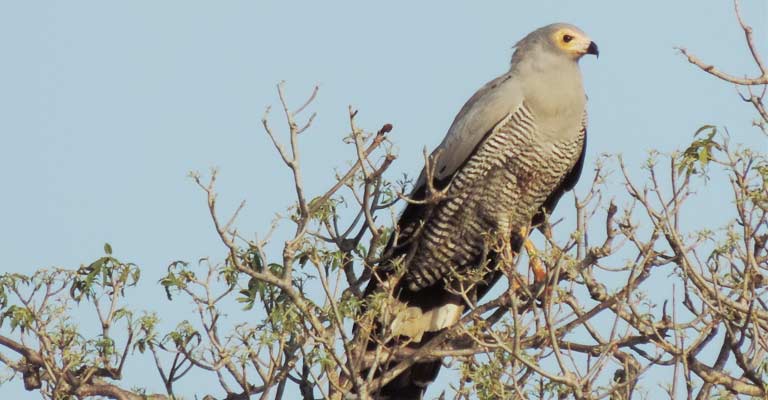
Understanding the habitat preferences of the Madagascar Harrier-hawk is crucial for identification.
This species is often found in open grasslands, marshes, and agricultural areas. Observing its presence in these specific environments can enhance the accuracy of identification.
Behavioral Characteristics
Paying attention to the bird’s behavior can be informative. The Madagascar Harrier-hawk is known for its low flight over the ground while hunting for small mammals and birds.
This characteristic hunting behavior, combined with its distinctive appearance, aids in identification.
Geographic Range
Lastly, the Madagascar Harrier-hawk is, as the name suggests, endemic to Madagascar.
Knowing the geographic range of this species is crucial for distinguishing it from similar-looking raptors in other parts of the world.
The Madagascar Harrier-hawk can be identified through a combination of distinctive coloration, facial features, wing and tail patterns, size and shape, habitat preferences, behavioral characteristics, and its restricted geographic range.
Birdwatchers and enthusiasts in Madagascar should familiarize themselves with these key features to appreciate and accurately identify this unique and captivating raptor.
Taxonomy of Madagascar Harrier-hawk
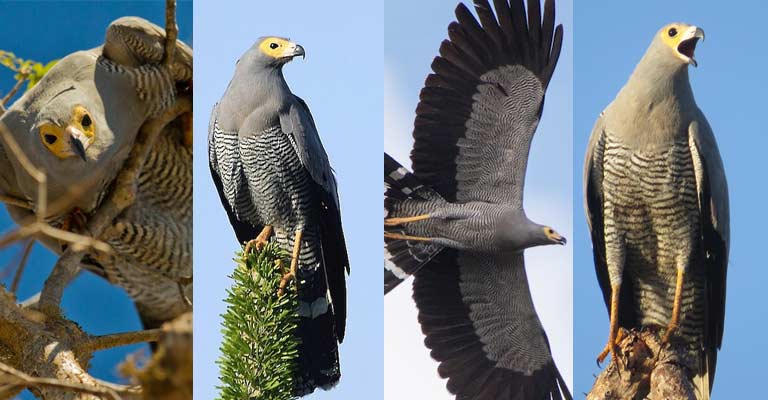
Here’s a table summarizing the taxonomy details of the Madagascar Harrier-hawk (Polyboroides radiatus):
| Taxonomic Level | Classification |
| Domain | Eukaryota |
| Kingdom | Animalia |
| Phylum | Chordata |
| Class | Aves |
| Order | Accipitriformes |
| Family | Accipitridae |
| Genus | Polyboroides |
| Species | P. radiatus |
This table outlines the hierarchical classification of the Madagascar Harrier-hawk, highlighting its place in the taxonomic structure from the broader Eukaryota domain down to the specific species (P. radiatus) within the genus Polyboroides.
Understanding the bird’s taxonomy provides valuable insights into its evolutionary relationships and biological classification.
The Madagascar Harrier-hawk (Polyboroides radiatus) belongs to the Animalia kingdom, Chordata phylum, and Aves class. It is classified under the order Accipitriformes and the family Accipitridae.
The genus of this unique bird is Polyboroides, and it is identified by the specific species name radiatus.
This taxonomy places the Madagascar Harrier-hawk within the broader context of vertebrates, birds of prey, and more specifically, the diverse family of hawk-like raptors, highlighting its evolutionary relationships and biological classification in the animal kingdom.
Madagascar Harrier-hawk Life History
The Madagascar Harrier-hawk (Polyboroides radiatus), an intriguing bird of prey native to the captivating island of Madagascar, possesses a captivating life history characterized by its unique adaptations, behaviors, and challenges.
Delving into various aspects of its life, we explore its dietary habits, preferred habitats, susceptibility to diseases, available treatments, and the ongoing conservation efforts aimed at ensuring the survival of this distinctive species.
Food
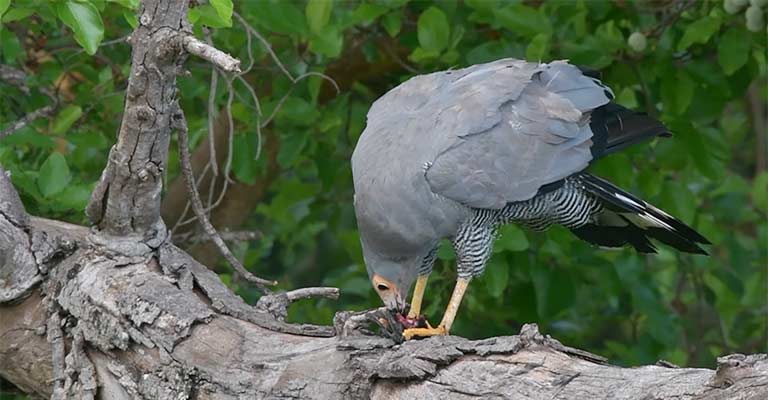
The Madagascar Harrier-hawk is a carnivorous raptor, primarily preying on small mammals, birds, and reptiles. Its diet consists of a variety of creatures, including rodents, lizards, and even small birds.
The bird employs its keen eyesight and agility in flight to hunt, often gliding low over grasslands and marshes in pursuit of its prey.
Habitat
This species demonstrates adaptability to diverse habitats, favoring open grasslands, marshes, and agricultural areas.
The Madagascar Harrier-hawk’s ability to thrive in different environments reflects its versatility in finding suitable hunting grounds and nesting sites within the varied landscapes of Madagascar.
Range Map
The Madagascar Harrier-hawk is endemic to Madagascar, and its range is confined to this unique island in the Indian Ocean.
Studying the species’ range map provides valuable insights into its distribution and can assist conservationists in identifying crucial areas for protection and management.
Nesting
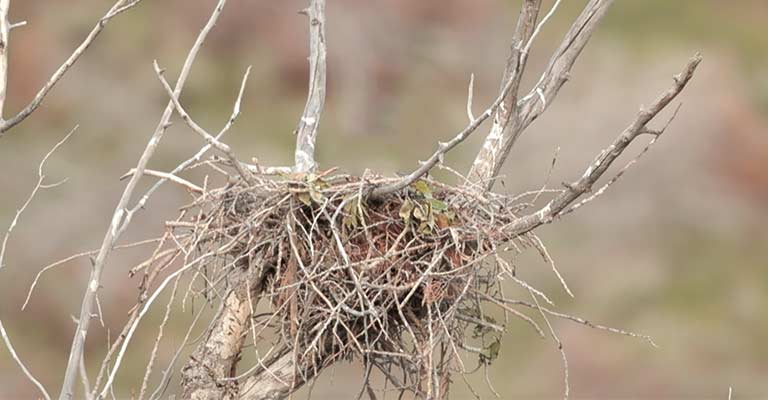
Nesting behaviors of the Madagascar Harrier-hawk are notable for their simplicity.
The birds often build nests on the ground, concealed within vegetation to protect their eggs and chicks.
The choice of nesting sites is influenced by the availability of suitable locations in their preferred habitats.
Here’s a table summarizing nesting details of the Madagascar Harrier-hawk:
| Nesting Details | Facts |
| Clutch Size | Typically 2 to 3 eggs |
| Number of Broods | Usually 1 per breeding season |
| Egg Length | Approximately 5.5 to 6.5 cm (2.2 to 2.6 inches) |
| Egg Width | Around 4.2 to 5.0 cm (1.7 to 2.0 inches) |
| Incubation Period | Approximately 28 to 32 days |
| Nestling Period | About 35 to 40 days |
| Egg Description | Whitish to pale blue-green with occasional markings |
| Nest Type | Ground nest, often concealed within vegetation |
| Nest Location | Typically in open grasslands or marshy areas |
| Parental Involvement | Both parents participate in incubation and care |
| Nest Building | Constructed from twigs, grass, and other vegetation |
| Nest Platform | Simple platform nest on the ground |
| Breeding Season | Often coincides with the dry season |
| Monogamous Pair Bonds | Male and female form long-term pair bonds |
This table provides a concise overview of the key nesting details of the Madagascar Harrier-hawk, offering insights into its reproductive behavior and the environmental factors influencing its breeding success.
Breeding
Breeding among Madagascar Harrier-hawks typically occurs during the dry season, ensuring a steady supply of food for the growing chicks.
These raptors are known for their monogamous pair bonds, and both parents participate in raising and caring for the offspring. This collaborative effort contributes to the survival and success of the next generation.
Diseases
Like many bird species, the Madagascar Harrier-hawk is susceptible to various diseases, which can impact individual health and population dynamics.
Monitoring and understanding these potential threats are crucial for effective conservation efforts.
Treatment
In cases where diseases affect the Madagascar Harrier-hawk population, intervention measures may include veterinary care, habitat restoration, and disease prevention programs.
The development and implementation of effective treatments require collaboration between wildlife experts, conservation organizations, and local communities.
Conservation
Conservation initiatives for the Madagascar Harrier-hawk focus on preserving its natural habitats, addressing threats such as habitat loss, and promoting sustainable practices.
Engaging local communities in conservation efforts is essential to ensure the long-term survival of this species and the biodiversity of Madagascar.
The life history of the Madagascar Harrier-hawk is a fascinating tapestry of adaptation, survival, and ongoing conservation challenges.
Understanding its dietary preferences, habitat choices, breeding behaviors, susceptibility to diseases, available treatments, and conservation efforts is crucial for appreciating and safeguarding the future of this unique bird of prey.
10 Fun Facts About Madagascar Harrier-hawk
The Madagascar Harrier-hawk (Polyboroides radiatus) is a captivating bird of prey native to the island of Madagascar, showcasing unique characteristics that make it a subject of fascination for bird enthusiasts.
Here are 10 fun facts about this remarkable raptor:
- Endemic Marvel: The Madagascar Harrier Hawk is exclusively found on the island of Madagascar, making it an endemic species. Its range is restricted to this diverse and ecologically rich island in the Indian Ocean.
- Distinctive Coloration: Sporting a contrasting color palette, this hawk exhibits dark brown upperparts and a chestnut underbelly. The black facial mask adds a mysterious and distinctive touch to its appearance.
- Low-Flying Hunter: When hunting, the Madagascar Harrier-hawk employs a unique low-flight strategy, gliding just above the ground. This behavior allows it to spot and pursue small mammals, birds, and reptiles with precision.
- Monogamous Bonds: These raptors form strong monogamous pair bonds, often lasting for multiple breeding seasons. Both male and female actively participate in raising their offspring, contributing to the species’ cohesive family structure.
- Ground Nesting: Unlike many birds of prey, the Madagascar Harrier-hawk builds its nest on the ground. Concealed within vegetation, the nest provides a secure environment for incubating eggs and raising nestlings.
- Seasonal Breeding: Breeding for the Madagascar Harrier-hawk typically occurs during the dry season. This timing ensures a consistent supply of food resources for the growing chicks.
- Varied Diet: Known for its versatility in hunting, this harrier-hawk has a diverse diet that includes small mammals, birds, lizards, and other prey found in its grassland and marshland habitats.
- Impressive Wing Span: In flight, the Madagascar Harrier-hawk displays a wingspan that, while not exceptionally large, is well-adapted for its low-soaring and hunting behaviors. The long, slender wings contribute to its graceful aerial maneuvers.
- Vocal Communication: Madagascar Harrier-hawks communicate using various vocalizations. Their calls range from high-pitched whistles to sharp screams, serving both for mate attraction and territory defense.
- Conservation Concerns: Despite its fascinating characteristics, the Madagascar Harrier-hawk faces conservation challenges due to habitat loss and human activities. Conservation efforts are underway to ensure the preservation of this unique species and its vital role in Madagascar’s ecosystems.
The Madagascar Harrier-hawk stands out not only for its distinct appearance and behaviors but also for its integral role in the ecological tapestry of Madagascar.
As efforts continue to conserve its habitats, these fun facts offer a glimpse into the intriguing life of this island-endemic raptor.
Wrapping Up
The Madagascar Harrier-hawk emerges as a captivating avian species, uniquely adapted to the diverse landscapes of Madagascar.
Its distinctive coloration, low-flying hunting style, and monogamous family bonds contribute to its charm. The ground-nesting behavior and seasonal breeding further highlight its adaptability in this island ecosystem.
However, conservation concerns underscore the need for continued efforts to safeguard its habitats and ensure the survival of this fascinating raptor, emblematic of Madagascar’s rich biodiversity. Thank you so much.